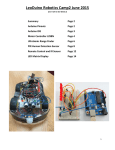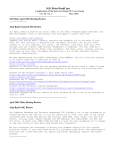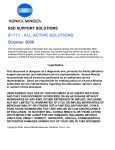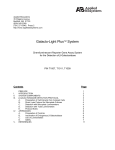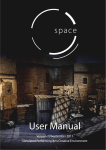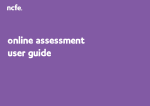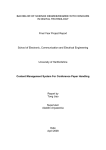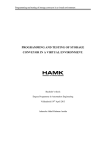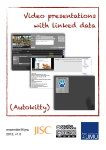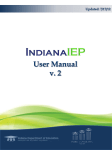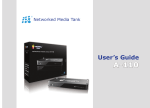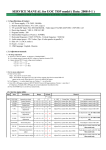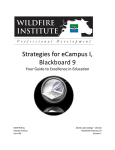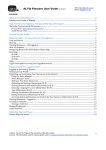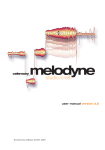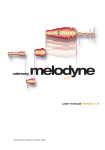Download PDF - University of Bedfordshire
Transcript
.~ I' University of Bedfordshire 1 INTRO D U CTI 0 N 3 2 BLENDED LEARNING 3 2.1 WHAT IS MODE 2? 3 2.2 WHY MODE 2 BLENDED LEARNING? 4 2.3 MAKING THE MOVE TO MODE 2 - BLENDED LEARNING 5 3 MODE 2 - WHAT STUDENTS CAN DO 7 3.1 DISCUSSION BOARDS FOR STRUCTURED DISCUSSION 8 3.2 B LOGSFOR REFLECTIO N 9 3.3 WIKIS FOR COLLABORATIVE WORKING 10 3.4 PRESENTATIONS ONLINE - WIMBA 11 3.5 E- PORTFOLIOS - PEBBLEPAD 4 CLASSROOM ERROR! BOOKMARK NOT DEFINED. CREATIVITY AND RICHNESS IN DELIVERY 11 4.1 USING AUDIO MATERIALS 13 4.2 USING VIDEO MATERIALS 14 4.3 CREATING RICHER PRESENTATIONS - WIMBA 4.4 COPYRIGHT 16 CLASSROOM 15 4.5 B RAI NSTORMING 17 4.6 TESTIN G KN OWLEDGE 18 4.7 FEEDBACK 19 5 HOW MUCH IS ENOUGH AND HOW IS IT MEASURED? 5.1 6 TRANSFORMING AND ENHANCING THE STUDENT EXPERIENCE THROUGH PEDAGOGy THE STUDENT EXPERIENCE ONLINE STRUCTURE & SCAFFOLDING 6.1 23 23 Structu re 23 6.1.2 Scaffol di ng 24 Goo D ACAD EMI C PRACTiCE 24 ACCESSIBILITY 7.1 8 21 6.1.1 6.2 7 20 MAKING ACCESSIBLE 25 = MAKING BETTER FOR ALL QUALITY ASSURANCE / QUALITY ENHANCEMENT IN E-LEARNING 25 26 8.1 QUALITY Assu RANCE 26 8.2 QUALITY ENHAN CEMENT 26 9 CURRICULUM DESIGN 27 9.1 LEARNING ACTIVITY DESIGN - JISC EFFECTIVE PRACTICE IN THE DIGITAL AGE 27 9.2 OPEN EDUCATIONAL RESOURCES- FREE STUFF! 28 OPEN EDUCATIONAL RESOURCESCOER) SITES ONLINE 29 9.3 29 10 ONLINE SUPPORT FOR LEARNING SKILLS REFEREN CES & RESO URCES 10.1 BIBLIOGRAPHY 30 30 Welcome to this, the second guide to Technology-Enhanced Learning at the University of Bedfordshire. This guide is aimed at staff who already have some experience supporting their students' learning in higher education through the use of technology and is intended to help you understand what characterises Mode Two delivery as defined in the TEL Strategy, building on Mode One's management of learning, moving towards more use of tools online. The University's strategic planning for the use of technology-enhanced in the Technology-Enhanced learning can be found Learning Strategy 2009-2011 on the Teaching & Learning web site. The TEL Strategy supports by the University's Mission Statement, the University's Education Strategy and the University's Curriculum Review for 2008 (CRe8). It is the University's policy that every BREO unit will have a minimum level of support for the student's learning as laid out in Guide 10. Research clearly shows that engagement and activity provide the best models for learning and wherever online learning can support that model, it should be considered for adoption, leading to greater provision of Mode 2 online learning, enriching the blended learning experience of our students. I hope that this guide will help you in your work. As well as the guide, colleagues within your department will also be a key point of contact and can provide local contextualisation for the topics covered here. Staff development sessions on the information in this guide are run from time to time (see the Teaching and Learning web site) or for further help or clarification then please do contact us. Mark Gamble, Head of e-Learning ([email protected] ) Mode 2 learning is active and engaging, providing students with opportunities to actually do things with new information, ideas, knowledge and concepts. In her 2003 article New Models for Online Learning, Carol Twigg writes about transforming courses: "Lectures are replaced with a variety of learning resources that move students from a passive, note-taking role to an active, learning orientation. As one math [sic] professor put it, 'Students learn math by doing math, not by listening to someone talk about doing math.' " (Twigg 2003: 2) Mode 2 is defined in the University's TEL Strategy as laid out in the following table. Mode 2 INTEGRATED Blended learning leading to significant enhancements processes - comprehensive to learning and teaching online provision integrated with face-to-face learning Communication Activities Provideintegratedcommunicationchannels(textand Providean environmentthat fosterscollaborative voice-based)to enablestudents,especiallyin disparate studentprojects,involvingsharedresponsibilityfor groupingsand locations,to exchangeinformationand resourcesandoutcomes,providingsignificant ideas,askquestionsanddiscussissuesrelatingto their opportunitiesfor studentsto personaliselearning. Students use communication tools and shared spaces learning. Provide specific opportunities and channels for students to manage and develop their own collaborative working and learning communities, including the opportunity to to collaborate on task processes and outcomes. Opportunities for reftection and e-PDP integrated and guidance given on methodologies (e.g. blogging) and best practice. build social learning networks. Provide integrated structure for students to evidence Provide on-line unit evaluation opportunities, coupled learning and personal development planning (PDP) collected online and presented at appropriate point(s) with feedback on actions taken as a result of previous feedback. by means of e-portfolio. Assessment Content Provide ftexible access to high-quality, reusable Provide structured and purposeful feedback to learning materials: may include structured gateways to students on their learning via computer-aided web and other resources with accompanying self-paced assessment for either formative (self-assessment and independent learning activities, adaptive release, monitoring of progress) or summative (examination interactive tutorials with feedback, simulations, study and grading) purposes or both. and learning resources and activities fostering Provide past assessment and / or exam questions and independent learning. model answers. Provide content in a broad range of media formats including podcasts and videocast to deliver rich learning opportunities. digital artifacts. Learning materials primarily delivered online - face-to- Likely to involve some assessment bye-portfolio. face tutorials reserved primarily for interaction. 2.2 May involve electronic setting, submission and feedback and return of student assignments using Why Mode 2 Blended Learning? The world we are preparing need to take advantage need to engage graduates of technology with technology graduate online and evaluate as a member user of technology in shared online spaces; in the last five years. We and learning because students being able to make use of a variety of their learning, increasingly their accuracy, of a team in an online context, collaboratively effectively - citizenship significantly teaching this involves tools to use in support with society needs to be a confident information to support as a skill- of tools and to select appropriate and their engagement for has changed requires their employability st it. The 21 century in order to seek out reliable relevance and usefulness; able to communicate and to maintain sources online effectively networks of to work effectively of contacts and work safely and in an online context. In delivering the curriculum we need to use technology • it sustains flexibility in when and where students • it sustains flexibility in when and where • it enables the support of students because may be learning; staff may be teaching; with learning difficult or problematic concepts develop over time, enabling or issues; • it makes for more effective use of resources; • repositories of learning materials richer learner experience; and activities an even • certain technologies develop and support specific skills; • it allows access to specialist learning materials developed by other providers; • it enables learners with different learning preferences to engage with learning at a deeper level; • it supports cross-campus working; • it provides an effective communication • online tools offer functionalities that are not available in the 'traditional' alternative; • we need to find new and better ways to assess increasingly large numbers of channel; students; • we need to provide quick, effective feedback in ways that ensure students receive and act upon it to make their learning more effective; • 2.3 it provides support for re-assessment when staff may not be easily available. Making the Move to Mode 2 - Blended Learning The change to Mode 2 for existing units is likely to be incremental. It is preferable to undertake one significant activity well, engaging students in a truly higher education activity, with all the attributes that go with it (criticality, creativity, research, evaluation, reflection) rather than peppering a unit with tools just for the sake of using technology. Although the term "Blended Learning" is subject to debate and question, it can be helpful as a reminder that this is, in fact, what good teachers have always done - that is, to blend together the range of tools at their disposal to make teaching and learning more effective. Today that includes a rapidly growing range of technologies, both computer-based (including using the Internet), and using other forms of technology, such as mp3 players and smart phones, interactive whiteboards and classroom voting systems. The nature and extent of the blend will be governed by a broad spectrum of circumstances: the nature of the course's learning outcomes, professional requirements, assessment strategies and access to technology. These will be modified by the skills of the teacher, and the capacity of the learners to utilise technology - and these skills and capacities can clearly be developed. What marks Mode 2 distinctively from Mode 1 is the extent to which the design of a BREO unit facilitates purposeful activity by students online. The CRe8 background briefing document, Stimulating Learning reminds us that '''Learning is not a spectator sport,1. We want students to be actively engaged in the learning process not just passive recipients. social and a personal process. At heart, learning is both a Students may learn from tutors, fellow students and other sources but what they learn becomes personal for them." http://www.beds.ac. uk/learn ing/cu rricu lu m/structu res/cre8 1 There are several references to this quote so its origin is somewhat obscure. For example 'Learning is not a spectator sport. Students do not learn much just sitting in classes listening to teachers, memorizing prepackaged assignments, and spitting out answers. They must talk about what they are learning, write reflectively about it, relate it to past experiences, and apply it to their daily lives. They must make what they learn part of themselves.' see Chickering, A. W. & Gamson, Z. F. Seven Principles for Good Practice in Undergraduate Education. AAHE Bulletin, March 1987, p. 3 - 7. While it is perfectly possible that a Mode1-style unit, predominantly used for the provision of content and unit management, will have a degree of Mode 2-ness about it - for example, a discussion board - the key difference is that the Mode 2 unit will have been planned or have evolved to blend face-to-face contact with online activities where the functions offered by the online environment will be a vital, integral part of the unit and the learning outcomes and assessment will be constructively aligned2 through structured online and face-to-face activities. For more guidance, see, Helen Beetham's Learning Activity Design from the JISC Effective Practice in the Digital Age guide. Any change to the curriculum intended to introduce e-Iearning and technology into the blend will need to be driven by a good understanding of the particular advantages that online learning can offer to enhance student learning. You will need to pay particular attention to the potential effects new practices can have on the quality of the students' learning experience. Thus, consider who your students are. If they are new to HE, will they have the skills to work largely independently online? What IT skills might they have, and what equipment will they need access to? Edinburgh Napier University offer the following advice as part of their Quality Framework guidance in Assuring Quality and Standards in Online Learning (Mainka and Smyth, 2006, p.2, and used with permission). Consider your subject before the technology. What are your students to learn, and how might online provision support this? If critical understanding is important, could discussion boards or blogs offer a more reflective exchange of views? For the coursework they are undertaking, would your students benefit from having a rich range of resources 'up front', or having shared online working spaces (eg wikis)? Look to the topic and desired learning outcomes, and only then explore the possibilities offered by online technology. Ensure online materials are at an appropriate level, have clarity, and can be studied independently without the need for high levels of remedial support. Make online learning purposeful. Provide students with a need to use online resources, perhaps through student-led online seminars, and have continuous coursework that requires students to engage with online materials, and with each other online, over the duration of a course. • Start small. If you are completely new to online technology, there are simple ways in which to become familiar with online tools before incorporating them into your teaching. For example, use the discussion tool first as an online problems' forum before moderating a subject-related confidence communicating • discussion, giving you the opportunity to gain online. Provide your students with clear guidance on the online learning requirements for your module or course. • Be accommodating of individual learning preferences by using relevant visual examples and other multimedia where possible, incorporating a search facility, and having options to easily print or download material. • Build opportunities for applying knowledge into your online materials, including suggested reflective activities and periodic self-test features. 2 For an illuminating overview of teaching and learning styles and constructive alignment, see Brabrand,C. (2006): "Teaching Teaching & Understanding Understanding" [19-minute award-winning short-film on Constructive Alignment available at http://www.daimi.au.dk/-brabrand/short-film/] • Provide relevant supplementary resources wherever possible, including a glossary and links to further reading, so that students can resolve any difficulty in understanding at the point it occurs, and to place the core subject matter in a wider context for those who wish to explore this. • If linking to external resources, ensure they are current, clear, and that any interactive content is unlikely to prove problematic for students to view. Perhaps paradoxically, the use of e-Iearning can provide a real opportunity to place a strong emphasis on the quality of the students' classroom learning activities. Using online technology can and should be seen as a way of making best use of contact time, freeing it up from mundane tasks. Rather than taking up valuable contact time to convey information and undertake unit and course administration, those functions should be transferred to the online domain, thereby liberating contact time for engagement with students, discussion, and working with students to help them to be more active learners. Thus, it can help manage knowledge transfer and thus support more deep and meaningful learning. These activities can be integrated with online activities using tools which can be used for capturing learning outcomes, creating richer learning resources, capturing otherwise ephemeral dialogue and discourse. In A Theory for eLearning, Mark Nichols (2003) suggests that the key factor here is that "the selection of education approach or philosophy is more important than the selection of the technology itself how technology is used is more important than which technology is used." The integration of technology into curriculum delivery must be driven by the needs of the learners and the curriculum. Examine the full spectrum of your units in the context of the whole course and ask yourself whether the student learning experience could be improved. Look at the learning outcomes, taking an holistic view and ask whether the activities in place are as effective as they could be - and whether they are constructively aligned. In Biggs' (1999) model of constructive alignment, he gives this easy to remember example: • Learning outcome = be able to tie shoelaces. • Learning activity = practise tying shoelaces. • Assessment = show that you can tie shoelaces successfully. What follows here is a guide to how particular tools can be applied to help and improve learning. Please do be aware that this is neither an exhaustive, nor a prescriptive list; rather it is intended to stimulate thinking and imagination about how tools could be used. The main tools that support Mode 2 working are Discussion Board, Blog, Wiki, e-Portfolio and - when set up for students to use for producing online presentations - WIMBA Classroom. The table below highlights where these tools can have particular applicability for supporting (a) the Realistic Learning strand from the CRe8 Curriculum Review and (b) the University Skills as defined in CIFs and UIFs. Realistic Learning "S Cl l: l: C1l Ql :!: Ql University Ql Ql Cl l: > :;:; Cl C1l > > :;:; :;:; u U Ql < ;: Ql 0::: l: ~ iii J: u •.. 0 .c ..!!! '0 u Skills l: olS l: J: .2 l: - -C1l Ql> C1l Ql- j (f) C1l •..o > o:::W Ql u :;:; C1l U uCll: :;:; 0- C1l ._ u••• C1l l: E ';: j E E Ql 'EO::: iii 0 0 U .;: olS:i; z..~ .- J: -•.. .~IC1l Ql U ./ ./ ./ ././ ./ ./ ./ ./ ./ Blog ./ ././ ./././ ./ ./ ./ ./ ././ ././ Wiki ./ ./ ./ ././ ./././ ./././ ././ ./ ././ ././ ././ ./././ ././ ./././ ././ ././ ./ ././ ./ ./ ./ ./ ././ ./ ./ ././ ./ Discussion Board e-Portfolio (Pebble Pad) WIMBA Classroom How well do students understand a concept? How can you capture students' thinking? In the face-to-face seminar there may be a significant proportion of the group who will prefer (for a range of reasons) to remain silent. And even if the seminar is particularly fruitful, it is nonetheless ephemeral, lost to review and future usefulness. There are a very wide range of opportunities where you could deploy a discussion board as a follow-up to providing content. As an alternative to face-to-face seminars, online discussion (Discussion Board) can offer (the particular advantages of online tools are in italics): • a structured discussion with a clear task that students can refer back to; • a discussion available over an extended period, so that students can all have the opportunity to take part at times that best suit them; • the opportunity for students to reflect and research before responding; • the opportunity to have students take turns (if you do this regularly) at leading discussions and summarising outcomes at the close; • a means of capturing the dialogue for review, revision and possible integration in future assignments; • a means of assessing understanding and focusing on misconceptions that is captured and stored for review by all; • a chance - if you think it appropriate - to allow students the opportunity to contribute anonymously, thereby encouraging contributions from the tongue-tied and reticent: • a means of collecting individual's posts for feedback; • a way of using formative discussion to help enrich and inform summative assignments: students use say 3 or 4 posts as self-referencing in their final submission. How? You can create a link to a discussion board anywhere in a BREO unit that allows content, including in a Learning Unit. All of a unit's discussion boards can also be accessed inside its Communicate> http://snipurl.com/sc2kv Discussion Boards area. Guidance can be found at in the Discussion Board chapter. See: Weller, M. (2003). Delivering Learning on the Net: The Why, What, and How of Online Education London: Routledge Falmer Ch 6 pp 80 - 95; Salmon, G. (2000). E-Modera ting: The key to teaching and learning online. London: Kogan Page Limited. Good practice in a discussion board has the following features: • a purposeful task, clearly related to learning outcome(s) and assessment; • a finite timespan, usually of more than a week and no more than three; • management of expectations: you should make it very clear how often you will be checking the discussion and what kind of contribution you will be making (you do not need to check every day, for example); • ground rules for acceptable behaviour and communication styles (for example, what maximum post length will be acceptable, can it be chatty or formal), agreed by all contributors; • guidelines regarding minimum expected level and style of contribution (will you be • guidance on how the activity will be assessed (it may be deferred, as in expecting inclusion of properly referenced research and reading, for example?); this discussion must be included in your written assignment"), 3.2 un posts from including criteria. 810gs for Reflection Developing reflection and criticality in students is a key activity in higher education. A number of professions require their members to function as actively reflective practitioners who keep an up-to-date portfolio. Reflection can be tied closely into an activity structured within BREO using the BREO blog tool or in PebblePad as part of e-PDP activities. You need to consider which main system and its particular style you want to use, but after that, blogs provide the opportunity to: • write in ways that are more than just a simple record of activities; • be able to quickly check students are actively reflecting and making progress; • prevent loss of documentation; • link evidence to a passage of reflection; • enable fast review of extensive reflection documents; • create reflections that are richer than paper-based records, incorporating images and sound, for example. For this activity to be successful, it is important to spend some time exploring and practising what it means to be a reflective writer within the context of your subject or professional area. Tool: blog, a linear diary, either shared or individual. How? You can create a link to a blog anywhere in a BREO unit that allows content, including in a Learning Unit. You can create one that is for the entire cohort, or one that is seen by student and tutor(s) only. Guidance can be found in the BREO Help area. You can also require students to blog in Pebble Pad as part of their POP work, integrated into the course. Read: http://www.heacademy.ac. hampton_solento9 uk/resou rces/detai I/resou rces/casestud ies/internationa 1_sout Good practice in a blog has the following features: • • a purposeful task, clearly related to learning outcome(s) and assessment; if shared (i.e. open to the whole cohort), ground rules for acceptable behaviour and communication styles, agreed by all contributors; • useful headings in order to assist searching and review; • a sense of narrative: telling a story • if reflective (rather than simply a recording), use of analysis, criticality and action planning. 3.3 Wikis for Collaborative Working Whatever your focus, it is likely that, at some point, you will have set group-work. Often the outcome will be a presentation, frequently using PowerPoint. While this can be a useful tool, it is usually linear in its execution and not easy for students to work on together, especially if they find it hard to meet face-to-face. The wiki offers a way of working online whereby 3 students can create a mini-web site without the need for programming skills. Wikipedia is probably the best known example of a wiki. The use of a wiki for delivering the outcomes of a group task can provide the opportunity to: • reflect, with students explaining to each other, sharing ideas; • engage in active learning, doing something with knowledge; • develop communication • work in a semi-structured, and negotiation skills; flexible online environment: new pages can be added and changed as needed; • foster deeper understanding: teaching (sharing) is often the best way of learning, potentially making the sum greater than the parts; • broaden scope of learning, bringing richness to the task, with each student bringing different perspectives to the team; • understand the work process where final, polished articles / outcomes evolve from ideas that are modified and developed, rather than as something immediately fullyformed; • develop desirable 21 sl century employability skills as a result of experience in groupworking in an online context. As well as using a wiki for groups to create a single, coherent piece of work for assessment, a more adventurous approach is to use it as a shared space to draw together materials to form a rich collection of learning materials contributing to the work of the whole cohort. With forethought and good management this can engage students in deeper learning as valued members of a learning community: instead of relying on the tutor to provide all the resources in the unit, the creation of learning materials becomes a shared effort, with all the associated opportunities to explore not only most recent thinking, but also methods of evaluating materials' credibility and worth - a valuable skill for the 21 st century graduate employee. Tool: wiki, a small, potentially shareable web site. How? You can create a link to a wiki anywhere in a BREO unit that allows content, including in a Learning Unit. Also, every user of BREO has access to their own wiki creation space under their Expo tab. Guidance can be found in the BREO Help area. See: http://campustechnology.com/Articles/2 Ed.aspx?sc 008/08IThe-Power -of-Wikis-in-H igher- lang=en&Page=2&p=1 Good practice when providing a wiki has the following features: • a purposeful task, clearly related to learning outcome(s) and assessment; • ground rules for acceptable working - users can edit (overwrite) each other's work in a wiki and this process should be clearly understood and guidelines agreed; • guidance on acceptable structure - students should think about how complex the navigation of their wiki should be, or have a structure imposed by the assessment and its marking criteria; • guidance on the inclusion of links to other sites; • students are given a guide word limit and page number limit; • guidance on accessing the wiki tool help pages and online user manual; • guidance on use of quotation and referencing (wikis as assignments are subject to similarity testing under the University regulations just as much as an essay). For years, students have been tasked with working in groups and delivering their outcomes as Powerpoint presentations. Some of the disadvantages are listed above, but it presents particular difficulties if your students have limited opportunities to meet face-to-face. WIMBA Classroom can offer an alternative. As well as being predominantly a tool for tutors to use to deliver and work with groups of students remotely, it can also be set up to allow designated groups of students to have full presenter rights, so that they can enter the WIMBA Classroom, upload materials and make an archive recording of their presentation for sharing, review and, if appropriate, assessment. The result can be a rich, collaborative effort delivered by students who may be separated by great distances - and this is likely to reflect future modes of working and thus contribute to the development of a well-rounded 21 sl century graduate. For more information on WIMBA Classroom see section 4.3 below. e-Portfolios enable students to collect, collate and reflect on material related to their learning from a wide variety of sources and present the outcomes in different ways for different audiences. Thus, e-portfolios help students with their Personal Development Planning and employability through displaying the life-long learning skills required to benefit from higher education and to sustain their continued development beyond the University. The University uses PebblePad, part of BREO, as its e-portfolio system. PebblePad helps users create, store and review multiple 'assets' which can be aggregated into powerful presentational portfolios, called WebFolios, to provide rich stories of learning or achievement for a variety of purposes including: • • • • Assessment (formal and informal) Advancement (promotion or transition) Appraisal (including supporting personal tutoring and self-regulated study) Accreditation (professional bodies) • • Application (course, job, funding) Articulation (informative story telling) PebblePad includes a range of tools designed to promote reflection and encourage collaborative learning. It can be particularly helpful in supporting learners studying away from the campus on placements or through work-based learning. Tool: PebblePad. How? You will need to contact Learning Technology for access to PebblePad and discuss your needs beforehand. Once you have an account you can reach Pebble Pad from the BREO login page or directly at http://portfolio.pebblepad.co.uklbeds/ See: http://portfolio.pebblepad.co.uk/overview.asp Good practice when using PebblePad has the following features: • Students and tutors understand the advantages of using an e-portfolio • E-portfolios are an integral part of the learning process - not a bolt on • Tutors structure e-portfolio use to support pedagogic aims • Students' experience of e-portfolios is developed over time rather than in just one unit • Tutors help establish a clear link between e-portfolios and learner development and/or employability • Students are allowed to personalise their e-portfolios to reflect their personalities and individual needs Online you can provide richer resources than just text or slides - and so can your students. This is one of the benefits of support for learning online. Images and sound are certainly not new in education. What is new in the context of this guide is the variety of new ways media can be delivered to students and captured by them to be used in creating new learning outcomes. Links to external, freely-discoverable (i.e. by a Google search, for example) media materials can be easily made in BREO, either by you as a tutor directly on a page or perhaps in a wiki page as part of a resource package, or by your students using a wiki or a blog. 4 Studies in the sector have shown that many students are keen to make use of otherwise dead time (travelling, for example) to watch video material and listen to audio recordings related to their learning. Smart phones and iPods allow video and audio to be accessed when and where students choose and most of these will now also allow recordings to be made and then uploaded for storage and later incorporation into learning outcomes or used as artefacts to evidence learning in the University's POP process using PebblePad (see 3.5 above). In addition, it is now increasingly easy to separate out key parts of video and audio in order to focus just on the most relevant parts of the material and integrate it into structured, scaffolded blocks of learning called, depending on the context, Learning Units or Learning Objects. The former is the name given to the tool available in BREO for structuring activities which can contain most of the BREO tools and a wide range of content. The BREO Learning Unit works 4 See particularly the work of the RLO-CETL, the CETL for the design, development objects at http://www.rlo-cetl.ac.ukljoomla/index. php?option=com and use of learning content&task=view&id=17 <emid=98 much like a folder (so you can add items and change and move them around) but it is presented to students in a usefully structured way which particularly suits the use of integrated media materials. You can find helpful advice on still images, moving images and sound online at http://www.jiscdigitalmedia.ac.uk/. JISC Digital Media, formerly TASI, exists to help the UK's FE and HE communities embrace and maximise the use of digital media - and to achieve solutions that are innovative, practical and cost effective. 4.1 Using Audio Materials If a student has a reasonably up-to-date mobile phone, it is likely to be able to play audio files in the form of mp3 files. Many students will have iPods of one form or another and carry their music collections around with them. In this way they can receive learning materials that are richer and more focused and potentially therefore more effective for learning, especially if they can be accessed when the student needs them, such as in a workplace learning situation. One approach might be to provide a pod castS stream with regular (possibly weekly) bulletins that highlight key learning points or point to useful new resources. Benefits of using audio materials can include: • helping to make the possibly impersonal online learning environment more human and engaging; • adding variety in the means by which ideas and information is conveyed; • creating an engaging cycle of interest if used regularly (weekly, say); • providing non-English speakers an opportunity to practise listening to language in the subject context; • creating a reviewable library of audio materials which can be reviewed; • providing focused and targeted revision materials in the lead-In to any examination; • providing audio feedback on an assignment. Students can also use their own technology to record audio: perhaps an interview with a professional to support some project work, or their own reflection when undertaking some field work or on placement. Provided the assessment required is planned to accommodate it, this kind of evidence of learning can provide students with more realistic opportunities for capturing and reflecting on their learning. The resulting files can be uploaded into either BREO or Pebble Pad for inclusion in online learning outcomes, such as a blog or a wiki or an e-folio, provided they have been sensibly compressed to a manageable file size.6 Tool: Audacity on a computer, or using a hand-held recorder, including smart phones. How? Use a headset-microphone for individual recording with free software such as Audacity (works on both PC and Mac). Or use mp3 recorder or smart phone. You can upload an audio file into BREO in any content area, or, ideally, into a learning unit as part of a structured activity. If you are podcasting, you can create a separate are with its own navigation in the left-hand column by using Control Panel> Manage Menu. 5 Podcast - a term frequently misused: podcasts are audio files, but audio files are not necessarily podcasts. A podcast is something a user subscribes to and then any new episode is automatically downloaded whenever the source is accessed, typically onto an iPod. Hence "podcast". 6 A Google search for "How to compress audio files" returns a range useful options. See: LTU guide on Podcasting, available in BREO under the LearnTech tab, section User Manuals. Also the SIG Podcasting for Pedagogic Purposes at http://podcastingforpp.pbworks.com/ and http://ppp.chester.ac.uk/index.php?title=Main Good practice • in delivering audio for learning has the following Page features: it is delivered at a measured pace with clarity and careful diction (for exemplars, listen to BBC Radio 4); • tone of voice is neither too bouncy, nor a dull monotone; • it is succinct and to-the-point - do not script, but make a list of salient points for the recording; • it starts with a welcome and introduction and ends with a brief summary; • the recording lasts for an appropriate amount of time - probably 10 to 20 minutes is enough: consider how it will be received by your audience; • for feedback, remember how tone of voice can colour the words you say; • use a sensible level of compression for the audio and check carefully the resulting file size - try a test recording to ensure all your students can access it before you undertake something important. 4.2 Using Video Materials You can provide video for your students on BREO. It can come from a range of sources: • recorded by you with a camcorder, or perhaps a Flip Video? or good quality mobile phone; • • recorded professionally for you by arrangement with LTU; discovered by you on a publicly-accessible website, such as YouTube, iTunesU, Vimeo, bliptv, or videojug; • by off-air recording within the University (see ISO Helpdesk). Many of us today have mobile phones that will store and play music and video. Most will take still pictures and, increasingly, they will capture video. If you have discovered useful video online, provide a link to the location. If it is on YouTube (or vimeo or blip-tv) you can embed the player itself in the web page and this helps students, since it mimics web pages they are likely to be familiar with and helps later when students are going back to revisit and review earlier material. It is also the best way to stay on the right side of the copyright laws. You must not digitise commercial video yourself and upload it into BREO (see Copyright below). As with audio materials, many students will be equipped with video recording capability in their mobile phones or Apple iPod Nano. As well as receiving material in video format, students can create their own for uploading into collaboratively-created learning resource collections, contributing to the learning materials for the unit itself. Provided there is sufficient critical reflection, analysis and thought applied, this will be likely to contribute to "students exploring their learning approaches and improving their effectiveness as learners and hence increasing their self-esteem and self-efficacy, accommodating learning students' personal styles and preferences by multiple teaching and assessment methods and valuing and acknowledging the diversity of students' experiences and drawing on these in learning and teaching approaches and activities" (Source: Cre8 Summary Table). Tool: capture with a good quality smart phone, a Flip or min-DV camcorder, edit with MovieMaker (PC) or iMovie (Mac); discover video online via a browser search engine or visit a video online site (see 9.2 OER references). How? Contact LTU - see LearnTech site in BREO. See: search Amazon for books on "shooting video." Good practice in delivering video for learning has the following features: • your video does not distract because of its quality: recording video is easy, but recording quality video with good sound is more challenging and LTU can offer many years of experience and good advice / training; • original material shot by you, where you are certain there is no copyright issue, should be uploaded onto our media streaming server: the University policy is wherever possible, to deliver video in Flash format, so LTU will convert your video and upload it; • material is chunked if there is access to it to edit it, or, if you are pointing students to a source on another web site, give instructions regarding where to start and stop watching the video; • students are given clear guidance regarding what to do as a result of seeing the video; • 4.3 the material is integrated into a learning activity, ideally integrated into a Learning Unit. Creating Richer Presentations - WIMBA Classroom If you have students who are largely at a distance and whose direct contact with you is limited, you might want to provide them with narrated presentations which can include sound (voice, sound effects), graphics (photos, drawings, pictures), the ability to incorporate web pages and a whiteboard. WIMBA Classroom is an externally-hosted tool added in to BREO which can be provided in any content area of your BREO unit. You can use this live with anyone enrolled on your unit who is anywhere in the world (so you could collaborate online with co-tutors as well as your students). However, certain countries do have policies and practices that reduce the available bandwidth and access for this kind of technology. If you are contemplating using WIMBA Classroom in a new location outside the UK, you must ensure that you have explored any potential sources of compromise (local political controls or bandwidth management) with the intended audience, either individual students or a partner organisation. Do not assume this technology will work satisfactorily in all countries at all times; policies can change. 8 WIMBA Classroom offers the following features: Instruction & Reinforcement • Robust Electronic Whiteboard • Application Sharing • Flexible Content Area Discussion & Interaction • Break-Out Rooms • Emoticons • Public and Private Chat Classroom Management • Content Upload and Storage • Auto-populated Participant List • Use Review (activity) • Full-Featured Classroom Archiving Convenient & Easy-to-Use • Telephone Access • MP3 and MP4 Downloads • Accessible to the Impaired • Seamless BREO Integration • Follow-The-Speaker Video • Multi-way Video and Audio • Polls, Quizzes & Surveys Notice the item "Full-Featured Classroom Archiving" - what this means is that you can create a presentation and archive it for students to review at any time. Normally, only you have control of the tools in a room, but if you wish, you can even set up a room which allows students all the tools of a presenter. In this way, remote students can create a presentation, individually or in a group and archive it for you to review and grade, if you wish. NOTE: in the event of a serious compromise in your ability to deliver learning, or students' ability to attend (such as in a pandemic where a site may be quarantined, or in sustained bad weather) WIMBA Classroom will provide the University with an effective alternative to face-toface activity, both delivering opportunities for live engagement and for these presentations and discussion to be archived for students returning to their studies after any prolonged illness. Tool: WIMBA Live Classroom deployed in a BREO content space How? From the drop-down menu in any content area, select WIMBA Classroom and click on Go, then follow the on-screen instructions. See: http://www.wimba.com/solutions/highered ucation/wi m ba_classroom _for _ higher_ ed ucation/ Good practice using WIMBA Classroom has the following features: • notify all intended participants in good time; • ensure all participants know they must ensure their computer is set up correctly using the provided Wizard tool - log in well before the planned session; • if the session is to be archived, ensure all participants are aware of how the archive • archived sessions are named consistently and clearly in order to enable later may be used that they all agree; retrieval; • plan the first session for familiarisation, scheduling plenty of time for testing and be alert for possible misunderstanding; • as with any other engagement, allow plenty of time for interaction, including allowing students to present, taking surveys and polls, and seeking feedback using the emoticons (smileys); • 4.4 test any links to web sites and uploaded materials before the event, ideally with a distant user (a colleague perhaps) to ensure all parts of the intended activity deliver. Copyright It is the policy of the University of Bedfordshire to abide by the laws of copyright: the 9 University Learning Resources Centre provides Copyright Guidelines and their handy booklet can be downloaded as a pdf file 10 As to the recording and delivery of media material, especially that delivered by broadcast, the University subscribes to the Educational Recording http://lrweb .beds. ac. uk/libi nfo/servtostaff/copyright 9 1 0 http://lrweb .beds. ac. ukllibi nfo/servtostaff/copyrig hUCopyrig hi. pdf Agency" ERA+ licence, and is a member of the BUFVC which gives access to BoB National, an off-air recording and media archive service which is available to BUFVC members holding an ERA+ licence. This low cost TV scheduling service allows University staff and students to record programmes scheduled to be broadcast over the next seven days as well as retrieving programmes from the last seven days of recorded channels. Through ISO, the University also provides its own in-house server-based off-air recording system, and both staff and students may request recordings to be made. Once they have been made, links to view them can be added into BREO pages. If material can be freely discovered on the internet by a general search (such as in YouTube, Vimeo, BlipTV, VideoJug and iTunesU) it is acceptable to provide a link to it. However, tutors should be aware that just because material is available on the Internet in no way does that assure its legality. If you have discovered material that you believe is essential for your students' learning and you are unsure about its legality, you should attempt to contact the copyright owner to ensure it can be used in the way you envisage. Under no circumstance should you attempt to digitise commercial material, either audio or video, yourself, and upload it into BREO. Always consult LearnTech if you wish to make media materials available online and it is not already in existence online. Original video, either shot by you or by LearnTech, can be uploaded in BREO, since we own the copyright. To see what is possible, take a look at the LearnTech tab in BREO and click on the Media Examples button - you will need to scroll the left-hand menu bar down to find it. 4.5 Brainstorming Traditionally in the classroom the outcomes of a discussion were captured using a flipchart and pen. This was inevitably difficult to store and share among the contributors, although the outcomes of a discussion written onto a flipchart can be captured with a digital camera and the resulting file uploaded and e-mailed to participants - somewhat laborious. If written onto an interactive whiteboard (a Smartboard, such as can be found in many of our smaller classrooms and in the student pods) the notes and diagrams can be captured as screen grabs and saved as graphic files. But they cannot be commented on, clustered into subsets and then voted on anonymously. l2 Enter FacilitatePro , a server-based software tool that allows just that. It can be used as a live capture tool in a face-to-face brainstorming session or online over a limited period; it offers brainstorming, prioritizing, evaluating, surveying and using action planning tools that make meetings into opportunities to access creativity, solve complex problems, and take decisive action. Accessed via a standard web browser, FacilitatePro can be used live face-toface in meeting rooms to improve group productivity or in an online asynchronous setting, where participants can use the tools to contribute to an ongoing meeting at their convenience. Tool: Facilitate Pro How? Contact LTU for an introduction and guidance. See: http://www.facilitate.com/ Good practice using online brainstorming • 11 has the following features: be prepared beforehand - check the agenda, understand what is the objective of the session and allow lead-in time; http://www.era.org.ukJ '2 http://www.facilitate.com/technology/ • commit to attending and paying attention: remove distractions; • check the technology works and you understand it - this includes your own computer; • take responsibility for taking part; • fully participate and give your name before speaking; • be aware of who else is online, possibly for later contact. 4.6 Testing Knowledge If you are uncertain how your students' understanding is progressing until they make their final submission, then it's a fair bet that some of them will either be misunderstanding, confused or following the wrong direction. And they, too, may well be unclear about whether or not they are on track with their learning. One of the ways to help reassure (or redirect) students, particularly at Level 1 and particularly with knowledge-based aspects of the course, is to provide them with frequent, short tests and quizzes, set to automatically themselves and provide reinforcement, mark guidance and feedback. Online tests and quizzes used formatively can: • reassure students that they have understood key elements of the curriculum; • provide feedback to both reinforce understanding (in the event that an answer was correct as a result of guesswork) and to guide students to the correct answer in the event they got it wrong; • with multiple attempts, allow students to retake until they achieve 100%; • be used to gatekeep progress by using Adaptive Release: students must achieve a pre-determined outcome before they are granted access to the next stage of their learning online; • help you to keep track of student engagement, depending on the frequency of the quizzes (a short weekly quiz can be a powerful encouragement to engage); • help students understand both their own assessment of learning and the subject matter if they are party to writing the questions. You may be surprised (and pleased) to note that you do not have to write all questions yourself. In fact, you might not need to write any! A very successful transformation of a unit in the University with poor achievement happened when the tutor required the students to research and write their own questions, answers and feedback based on the important, but not very exciting content of the unit. They posted them in a blog and received fast feedback from both tutor and peers. Students both understood the assessment process better and became much more knowledgeable about the subject matter: the grade mark average shot up! You should note that computer-based assessment (i.e. a computer-delivered examination using, for example, multiple-choice questions) online in BREO must only be formative; it is not possible to exclude other Internet sources on an individual's computer and therefore any student taking a test on their own computer can access the entire Internet to search for answers. Similarly, the University does not currently provide an online authentication method and therefore, without an invigilated environment, a student's identity cannot be verified. High-stakes, summative CBA must be undertaken in an invigilated area using QuestionMark Perception, not BREO. Contact Learning Technology for guidance. Tool: quizzes in BREO Test Manager, a range of some 18 question types, many autograded. How? You can create a link to a quiz anywhere in a BREO unit that allows content, including in a Learning Unit. Guidance can be found in the BREO Help area. See: http://www.reap.ac.ukl and http://www.brookes.ac.uklaske/ Bull, J. (eds) Computer-Assisted and Brown, S. Race, P. & Assessment in Higher Education. Kogan Page, London. 1999. • the quiz tests knowledge, rather than memory recall; • wording is clear and unambiguous, testing the subject, not the ability to decipher the question; • the knowledge being tested is appropriately pitched to the student's experience level; • the test uses the most appropriate question type for the area of knowledge being tested; • all questions are sUbject to rigorous quality control checks by subject experts; • the final quiz / test contains sufficient instructions on how to navigate the test, ensuring that less computer savvy students cannot be disadvantaged; • all questions have useful feedback for both incorrect and correct answers - students may have got the answer correct by deduction or luck, rather than for the right reason, so use feedback to reinforce correct knowledge. Assessment of learning is what many of us experienced in our own student lives: a hurdle at the end of the course which challenged us to either clear it or fall. This model is adequate to merely act as a filter (i.e pass or fail), but it does not actually help students to stay on track in their learning. Assessing for learning relies on an iterative process of learning activity review and feedback. CRe8 emphasises the centrality of assessment to student learning not just as an act of measurement or certification. In the literature there is much criticism of assessment practice in HE in terms of not enabling students to learn effectively. "Students may well escape from poor teaching through their own endeavours, but they are trapped by the consequences of poor assessment,,13. The CRe8 Guide to Assessment for Learning http://breo.beds.ac. uklwebapps/lobj-wiki-bb_bb60/wiki/cre8'- 413286_1/a4_feedback Planning a course carefully to take full account of the assessment process can make the final assessment easier on all parties. Establishing a set of milestones at which staged progress can be assessed formatively allows 'quick-and-dirty' feedback to be delivered electronically at key stages when it is most likely to be received and acted upon. Tutors can make informal assessments for their own records, keep a record of the feedback delivered and thereby face a far less demanding task when it comes to final assessment, building on the informal assessments already made. Electronic feedback can be delivered in many ways: 13 Boud, D (2006), forward in C Bryan and K. Clegg (eds.) (2006) Innovative Assessment Education, London, Routledge, p.xix. in Higher • Word files submitted via the BREO Assignment tool and then marked up with inserted commentary and highlights or possibly even with audio recording added in, then returned via the same tool; • audio commentary using an mp3 recorder or Audacity on your PC (GarageBand on a Mac) to create audio files which are then sent back to the student directly via e-mail or via the Assignment tool; • students keeping a reflective blog, which the tutor reviews and adds comments as feedback; • students working on creating new learning objects using a wiki, which the tutor reviews and adds comments as feedback; • using the Grademark tool in Turnitin. Tool: BREO Assignment; MS Word; Audacity (PC); GarageBand (Mac); blog and wiki comment tool How? Contact LTU to discuss your needs and the best approach See: The CRe8 Guide to Assessment for Learning Good practice using feedback has the following features: • • it is quick and provides guidance for improvement for all grades; it is relevant and linked to learning outcomes, assignment task and assessment criteria; • students know where to find it and how soon after submission to look for it; • it is clearly identified as feedback; oddly, some students will say they have not received feedback, when they have, simply because they have not registered it as such and sometimes, when students complain about lack of feedback, it may be because they do not recognise it as such. Are my units at Mode 2? Rather like many students, you might want to know how they are assessed for "Mode 2-ness." Perhaps it would be helpful to go back to outcomes: what are we trying to achieve by promoting the use of technology-enhanced learning and what does that mean anyway? We are emphatically not promoting the use of technology simply because it is there: we don't want you to say, "There's a discussion tool - therefore I must find a way to somehow lever one in to my BREO unit online." Rather, it is a case of thinking, "I should discover what new tools can offer and, if I have a problem getting students to understand a concept, then a new approach using a new tool could help to solve it." The quantitative measure of the nature of a unit (its "Mode-ness") is derived from a quantitative measure of the nature of its contents (the incidence of discussions, blogs, wikis and rich media files) together with the frequency with which students engage with these tools. The example matrix below shows the range for one department (the heavy line, "Dept X") against all University departments and divisions (the pale grey lines). For this matrix, it is very important to note that it does not indicate a progression over time: it is not a graph. Rather, each line indicates the range of modality-activity point of any of a department's for each department: at the left is the lowest units; at the right end (point 'A') is an averaged high point for all of your units, arrived at by using the highest modality value for the unit scoring highest in modality, together with the highest activity value (Sept-08 to Jan-09) for the unit scoring highest in activity for the department. As such, the top point ('A') may not represent any single existing unit in BREO. There is also a point, typically about a quarter of the way from the left end of the line (which may manifest as a kink in the line), which indicates the average point for all the units in one department's portfolio. o~-- o 40 10 Modality Over time, as departments and divisions develop their strategies and approaches to teaching and learning, so the values on this matrix should be seen to move up and to the right. One developmental 5.1 approach is that devised by Edinburgh Napier University: TESEP. Transforming and Enhancing the Student Experience through Pedagogy The following section is used with permission of Edinburgh Napier UniversityfTESEP, extracted from http://www2.napier.ac.uk/transform/rethinking references provided. Edinburgh Napier University's TESEP 14 through Pedagogy) project and is t/ 2.htm and the other (Transforming and Enhancing the Student Experience proposes that the process of changing teaching practice in order to transform the student experience is an iterative one and that it is possible to implement the TESEP principles in a number of ways that effectively represent different 'degrees' or 'stages' of transformation. The overall aim of the project is to draw on existing good practice in FE and HE to investigate how current and emerging technologies can underpin a truly learner-centred teaching approach. Two simple assumptions drive this aim. • The first is that to make a real difference to the student experience, we must involve students in increasingly active, self-directed learning from an early stage in their studies. • The second is that technology, when it is used appropriately, can playa very important role in this process, particularly where students locate material, undertake formative assessment and, critically, where effective collaborative working and critical discussion with peers is to occur. Three broad stages of transformation can usefully be identified, with each having different implications for teaching practice, how technology might be used and for the roles and responsibilities of the learner. Enhance: Making simple and often subtle adjustments to teaching practice, involving straightforward but effective uses of technology and structured peer support opportunities, could result in an improved and more active experience for the student. Extend: Developing a blended approach, involving the use of online tools and resources for collaborative and individual tasks, that is always at least partially student-led, can be introduced to offer new opportunities for learning or to extend classroom activities in ways that provide more choice and control in what, when and how students learn. Empower: The teaching approach taken in a unit or course can be re-designed so that learning is driven from the outset, as much as possible, by the needs and interests of the learner within a framework of support that is established by the tutor in a primarily guiding role, and where technology is used to offer independence and autonomy in learning. Enhance --------- I Simple adjustments to teaching practice that give more responsibility to learner I "'" actr Extend I New and further developed opportunities that require learner to make key decisions about how and what they learn Empower I Teaching is re-designed to ensure that learners needs and interests drive the learnilg experience l learne< Peer support opportunities Tneengagr leame< "'" au,onor""' learn••. Collaborative practice _~__________________ Comparable kinds of tasks as they might be implemented 111 Online problem forums improve tutor/peer support Unks to relevant online case studies for students to explore Classroom lessons involve---group break-out tasks for investigating key issues Student-led -----online seminars Students source and debate-their own case studies online Classroom lessons are ---A alternated with weekly research and report tasks at each stage Online discussion tasks generate rather than complement core content Students produce an online case study on a chosen topic problem-based project provides the focus for learning from the outset Students across the board are generally very appreciative of BREO, but one of their key requests is to "increase consistency in the use of BREO by staff.,,15The responsibility for achieving a consistent, holistic learning experience across a course relies on thoughtful structure and scaffolding and it is very much in your hands, working in harmony with colleagues on your course team. 6.1 Structure & Scaffolding For the online aspect of a well-managed blended learning unit to work most effectively, students need to be provided with a clear and transparent structure for navigating the 16 contents of the course and - at least at the beginning of students' learning - a scaffolded approach to the activities you have devised to facilitate their learning. 6.1.1 Structure As described in Guide 10, section 3.1, it is important to devise an intuitive, intelligent structure for your BREO unit. The most common structure is likely to be based around blocks of learning. Consider how you would like to work online if you were a student on your own unit. Consider especially a point well into its period of delivery when you might need to go back and find an earlier activity or resource. Work this through and, ideally, plan it on paper, particularly so that you can see how many layers deep your navigation is likely to go. A good rule of thumb is that no item should be more than 3 clicks of a mouse button away from discovery. This rule will probably mean that your navigational list on the left is long and therefore shallow, with many links to areas that contain folders within folders within folders. Use the Manage Course Menu tool in the control panel to set up the menu to suit, remembering that it is better to have more items visible in the list on the left than to put items within folders in these areas. In this way, you might have a structure based around weeks or around blocks - and you might use relevant names for the blocks, if appropriate. For example: • • • • • • • • Week 1 Week 2 - 4 Week 5 Weeks 6 - 10 Block Block Block Block 1 2 3 4 Whatever you choose, to help students find their way around online, there should be a clear breakdown of what learning takes place where, certainly in the Unit Handbook and ideally in a separate area in the BREO unit (labelled something like Unit Management or Unit Admin). Remember to do all you can to help your students, making it easy for them to work with what you have provided. The more effective and transparent you can make this navigation the easier your life is likely to be: if your students are confused by what you have provided, who will they come back to? That's right - you. And remember, students demand consistency across the units in a course, so you will be doing them and you a favour if you ensure commonality of provision and navigation across all units of the whole course. Similarly, never underestimate the usefulness of engaging students' opinion about their interpretation of whatever structure you have devised - and of the instructions that you have provided to help them understand what you require of them. 15 Source: Student written submission to the QM 16 http://projects.coe. uga.edu/eplttlindex. Institutional Audit Nov / Dec 2009 php?title=Scaffolding#What is Scaffolding .3F Have you ever been confused by instructions on how to do something or find something online? You can avoid subjecting your students to this experience (and having to deal with the ensuing problems!) by testing your structure and guidance on willing students before fully implementing them. 6.1.2 Scaffolding Just as a building needs scaffolding until it can stand alone, so scaffolding learning is a very effective way of helping to grow your students' abilities and confidence as autonomous learners. Activities online frequently fail because students have not been provided the scaffolding that would help them both understand the medium and the part they play in it. There are different ways to scaffold instruction for students. According to Bransford, Brown and Cocking (2000), some educators favour an apprenticeship model whereby an expert models an activity, provides the learner with advice and examples, guides the student in practice and then tapers off support until the student can do the task alone. Others prefer methods that encourage ongoing use of tools and consultation with other people, arguing that in real life few people ever work exclusively on their own. Most agree that scaffolding is particularly effective in areas in which students need to be more self-reliant, such as technology-based learning (Banaszynski, 2000). There are plenty of opportunities for doing this in an online context with text-based guidance, narrated slides or screen-grabs, audio files - possibly delivered as pod casts - and video. Early units in a course, in Year 1 and into Year 2, should include very clear instructions for both using BREO and undertaking learning tasks. Although you may want students to engage quickly with theories and concepts, they must also have the academic and technical skills to be confident and successful, so they will need guidance and time to develop and practice skills: literature searches; using discussion boards; reflective writing; blogging; synthesis; using a wiki; exercising criticality. Learning skills and technology skills go hand-in-hand for the 21 st century learner. But aren't they all "digital natives"? This term, coined by Marc Prensky (2001) has largely been debunked. The idea was that children were born into a world where the PC is ubiquitous and were therefore naturally highly competent users of the digital domain - native, in other words. The reality is that some people are competent and practised, and some are not. The generalization does not hold and they are better characterized as having "digital wisdom" Prensky (2009). Nor does the notion that regular users of Facebook and the like can automatically transfer the skills used therein into an academic context: do not assume that your new students can use BREO effectively just because they use Facebook. Good academic practice characterised by proper citation and referencing is a challenging topic for many students new to higher education, especially those who come from an educational context which often encourages a magpie approach to learning. This is, of course, supported by the Internet where almost anything can be found, copied and re-used. Helping students to understand ethical behaviour in an HE world is highly important and the online tool Turnitin can help you with that. The first and most important thing to emphasise is that Turnitin is absolutely and emphatically not a plagiarism detection system. It is a system which compares text with text found on the Internet and in databases and then highlights any matches found. This provides you with the intelligence necessary to assess the nature of these matches and then make an academic judgement regarding the likelihood of intentional plagiarism having taken place. Notice the use of the words "judgement" and "intentional" - there must be evaluation of each case by the academic concerned (you) and there must be intent to cheat. Given the difficulty many students have with understanding plagiarism, Turnitin should be used formatively at first with all students where possible. There is a guide 17 on the BREO LearnTech site explaining how to set up and use Turnitin which you can download in pdf format (or request from Learning Technology) and slides 18 to illustrate what the system delivers. It is a good plan to use these with new students to introduce them to the technology and then give them one opportunity to use the system formatively so they can develop and refine their practice. It is far better that students are taught how to avoid plagiarising by practising rather than being told and then caught out at first submission point. Policy and guidance can be found on the Teaching & Learning web site at http://www.beds.ac. Uk/learning/ 7.1 Making Accessible = Making Better for All When planning and creating online materials it is helpful to bear in mind that by improving the quality of materials or activities in order to make it more readily accessible to those students with special learning needs or health-related Southampton's 19 LEXDIS project issues all students benefit. The University of aims to explore, with the help of students, successful 'e- skills' and supporting strategies, including the use of assistive technologies, complex computer-based interactions introduced bye-learning in a world of and on-line social networks. It is intended for people like you who are using or developing on-line learning materials. All the strategies have been provided by students who have first-hand experience of e-Iearning. The site pulls together handy hints and tips on technologies you can use to make e-Iearning easier. Any technology that achieves this has been called an Assistive Technology. The reviewing students are disabled, and using these guides to refine your online offering means all students can benefit. 17 Guides: http://snipurl.com/s8dmj 18 Turnitin slides: http://snipurl.com/s8dmz 19 http://www.lexdis.org.ukl and http://www.lexdis.ecs.soton.ac.uklprojecU ()lhtul1y Lf"xdis Ideas for e-Learning Task • Tip of the Moment ~e~~:;~~~~~~~~~~a::~~on'~=C: ~~~~ra~1f;:V: ~1t~1=~ been CNle<Ian A$$l$tive Tectrdogy Are you MW 10 It. slle? \'Yhy not I You can brow.u:llnks • ,." ~ tor ,1aft ~ "i """" I\Olp I. oclOpl ",. ,IVlet us eo In YOOloocument and Idd .lIable or con1ents In Word • walch ... IT" to Lat_t •.tuoenta 10help m.e HNn.ng ma1ena.5 •. Some guldn how. been deve\opl'd • ~ Ihac ItveICfl1S uso <'urlr'lC) thOtr may cause IUlJeS • AUdtJ" TIC:mqtoga thM students use saw. SOf'I1IP of the ISSun eriSJng online ~ng Strategy Spot"y 'Of MIpmg concMfrdltOf1 •.• ,ieof 10 use and oICCu,ibl 10 lid OOA (Qf'nOlld"'lt •• You can ••••• ~::Sh~~:a:i:h=Se~:.,;,e wtth 1hat with their 51'a18gi.- 10 uareh by • Setec:ting dithculbfi andIOI' task5 to find illi1I5U1. • Em.nng. keVwordin lhe leiU'Ch bml. = SumfTHl'l'S·;tWt.... ~k:::~~~'::':Uh~~t:=~~= ~1 may "'58 in lIn chOtCes Of 1UU HNmirtg srluation. From there you wll ~ and Slt.t1CQ1CS pt'O'W'tdCdby tM SluOenls "09 The Access Group shows 011liS PfOtt'Cts at 1M Learring Soc~ies Lab Summer ShOwcas•. Need to search by Disability? offered The .fJ,Q!' f'tqect coheet, tdeaI 'or ..teamng. ptOVided by ItudlnCs uiing Auil1fVI TocMoiogiOi. Southarnpton ""\fR",n." 8.1 2009 Coo'ac' Us' L"""'ce.",""", "'00""" I' P"""" ! \( lee hO"IS T. Quality Assurance The QM Code of practice for the assurance of academic quality and standards in higher education deals with e-Learning issues in Section 2: Collaborative provision and flexible and distributed learning (including e-Iearning) which can be accessed online at http:// gaa. ac. ukl acad em icinfrastru ctu re/cod eOfP ractice/section 21defa uIt.as p#e lea rn wh ere you can also download a pdf of the section. University QA documentation can be found at http://www.beds.ac. uk/aboutus/ga/docu ments 8.2 Quality Enhancement In his paper 'Assurance versus enhancement: less is more' Colin Raban (2007) argues for an alternative to the dichotomy of assurance vs enhancement: "The improvement of teaching and learning and the dissemination of good practice are important; and conventional approaches to quality management can provide the intelligence and stimulus for this kind of enhancement. But these approaches are not conducive to more fundamental action on the deeper institutional factors that impact on teaching and learning; nor are they conducive to the promotion of innovative (and risktaking) practice and the creation of new curricular and organisational we require a 'modernisation' structures. For this of our quality assurance systems that would facilitate risk- taking and anticipate its possible consequences." For changes to be made to the learning experience of students at the University of Bedfordshire, therefore, it is vital that you understand the importance of undertaking a programme of change rather than addition. Piling technology on top of a traditional face-toface approach to teaching and learning will be counter-productive; the best way to successfully implement technology-enhanced learning in the curriculum is to use it to replace and / or supplement what is already there and not working as well as it might. Technology must be introduced because it offers a better way of addressing student learning needs - but something has to go to make way for the new. This is stating the obvious, but it is remarkable how many academics across the sector are resistant to change. In order for change to happen, as Raban says, staff (you, that is) must feel confident to attempt something new, supported by University systems and management structures, empowered to take risks, able to give up models and approaches you may have been using for years - or even longer ..... 9.1 Learning Activity Design - JISC Effective Practice in the Digital Age http://www.jisc.ac.uk/practice extract pg 12 A practitioner has several issues to consider when designing an activity to engage learners and further their development. The diagram A model of learning activity design illustrates these issues more fully. In practice, the elements of design are closely interrelated, but the model can be used as a checklist to ensure that all four aspects have been considered and brought into alignment with each other and with the underpinning approach to learning. Learning environment Tools, resources; alfordances of the physical and virtual environment Interac ion between ll?aml?rs and aspects 0 thl? learning environr'lent mpact of learning I?nvironment on ll?amlng outcoml?s Intended learning outcomes Acquisition of new knowledge, skills and abilities; evidence of these Roles o:hers play in facilitating learning outcomes Interaction between ll?arnl?rs and 0 hers involvl?d in the ac ivi y Other people Peers. tutors, facilitators, mentors, instructors Learners: their needs, motives for learning, prior experience of learning, social and interpersonal skills, preferred learning styles and expectations of the course and of the practitioner. Intended learning outcomes: the purpose behind the learning activity; internal or external goals and targets. In learner-centred approaches, intended outcomes will be strongly determined by learners' own goals or by learners' needs as diagnosed by a practitioner. In curriculum-centred approaches, formal outcomes will be more significant. Learning environment (face-to-face or virtual): physical and virtual spaces; available resources, tools, artefacts and services (including digital ones). Tools and artefacts are said to 'mediate' learning and the ways in which aspects of the environment support learning are sometimes called their 'affordances' for learning. Other people (co-present or mediated through technology): other people involved and the specific role they play in the interaction - for example, by supporting, challenging or guiding. Peers and collaborators are powerful mediators of learning and play an important role in supporting learners. Within the context of any activity, the interaction between these factors will be dynamic and unequal. The decisions that underpin design in any particular context will involve a range of mediating tools and resources and a variety of interpersonal exchanges, and will be influenced by the practitioner's perceptions of the learners' needs and the intended outcomes. It is unlikely, therefore, that the interaction and the decisions made will be the same in all circumstances. Essential to the enhancement of learning through technology is an understanding of the learning activity in its context, including the role of established tools and practices alongside more innovative approaches. Educational theory can help to define approaches that ought to work; educational research can help to describe approaches that seem to work, but only a skilled and reflective practitioner can decide which approach will work best in a given context. The complex art of choosing the best approach is termed 'design for learning'. 9.2 Open Educational Resources - Free Stuff! One of the most daunting aspects of providing learning activities online has been the prospect of having to create effective learning materials and resources anew. For many years there has been a growth in the availability of materials to be used online, especially by publishers keen to sell their textbooks - and these naturally come at a cost (cf. Pearson20 and Kogan21 Page as examples). However, as a results of external funding for projects such as Jorum, it is increasingly possible to find high-quality open educational resources (OER) freely available for re-use online and these can be linked as external websites within your BREO unit. In a THES article in September 2009, Rebecca Attwood offered these scenarios: "Visitors to The Open University's OpenLearn website can pick up a 16-hour module examining the Royal Pavilion's relationship with 19th-century Romanticism and exoticism. The course includes text, film footage, images of 18th-century engravings and learning exercises. The uncertain student, meanwhile, can replay Tuesday's lecture on his or her university's iTunes U site. There, too, the scientist can kick off with an hour-long romp through the history of 20 http://www.pearsoned.co.ukleLearning/ and http://www.coursecompass.com/ 21 http://www.koganpage.com/resources/freeebooks philosophy from the pre-Socratics to the present day with Marianne Talbot, departmental lecturer in philosophy at the University of Oxford. And the professor can download an entire course from the Massachusetts Institute of Technology (MIT) - including lectures, handouts, reading lists and assessment materials - to see how things are done there.,,22 Apple Learning Interchange http://edcommunity .apple .com/al i/ SSC Archive http://www .bbc.co. uk!arch ive/i ndex.shtml MERLOT http://www.merlot.org/merlot!index.htm EDNA http://www.edna.edu.au/edn EDINA http://edina.ac.uk/ EDINA Film & Sound Archive http://www.filmandsound.ac. INTUTE http://www.intute.ac.uk! JISC OER Projects http://www.jisc.ac. uk/oer JORUM http://www.jorum.ac. OER Commons http://www. oercommons.org/ Open Culture http://www.openculture.com/ Open Learn UK OU http://openlearn .open. ac. uk/ OER Wiki : OER list http://oerwiki. iiep-unesco.org/index. OER Wiki Repositories http://oerwiki .iiep-u nesco.org/index. ph p?title= Repositories SCRAN http://www.scran.ac.uk/ SlideShare http://www.slideshare.net! Wikipedia http://en.wikipedia.org/wiki/Main Wikiversity http://en.wikiversity.org/wikilWikiversity:Main a/go/h ighered/highered resou rces uk! uk! ph p?title=Portals Page Page and gateways skills' development integrated tightly into activities structured to support your students' learning in the context of your course. Search your HEA Subject Centre for case studies and resources relevant to your subjece3 and look for evidence-informed 4 Education teaching and learning at the HEA EvidenceNee . practice in Higher Help your students with broad 25 development of graduate skills with online guidance from our own Learning Resources site and also with the free resources from The LearnHigher Centre for Excellence in Teaching and 26 Learning (CETL), a partnership of 16 Universities . 10.1 Bibliography The University's TEL Strategy 2009-11 can be found in BREO at http://breo.beds.ac.uk/webapps/portal/frameset.jsp?tab 23 http://www.heacademy.ac. uk/ou rwork/networks/su 24 http://www.heacademy.ac.uk/evidencenet 25 http://lrweb.beds.ac.uk/help 26 http://www.learnhigher.ac.uk/ id= 682 1 first button bjectcentres The University's Curriculum Review for 2008 (CRe8) Briefing Papers are available on the CRe8 web site at http://www.beds.ac.ukllearning/curriculum Banaszynski, Joe, (2000). Teaching the American Revolution: Scaffolding to Success. Education World: The Educator's Best Friend. Accessed August 24, 2009, from http://www.educationworld.com/a curr/curr218.shtml. Beetham, H (2007) 'An approach to learning activity design', in Rethinking Pedagogy for a Digital Age, Beetham, H & Sharpe, R (eds), Routledge, pp26-38 Bransford, J D., Brown, A L., & Cocking, R R., (eds), (2000). How People Learn: Brain, Mind, Experience, and School: Expanded Edition. Washington, D.C.: The National Academies Press. Brown, S. Race, P. & Bull, J. (eds) Computer-Assisted Assessment in Higher Education. Kogan Page, London. 1999. Biggs, J. (1999) Teaching for Quality Learning at University. Buckingham: SRHE/OUP Downes S (2004) Educational Blogging EDUCAUSE Review, vol. 39, no. 5 (September/October 2004): 14-26. Hughes, A, (2009) Higher Education in a Web 2.0 World. Accessed August 242009 from http://www.jisc.ac. uk/pu bl ications/docu ments/heweb2. aspx Lamb, Brian (2004) Wide Open Spaces: Wikis, Ready or Not, EDUCAUSE Review, vol. 39, no. 5 (September/October 2004): 36-48. Accessed 23 September 2009 http://www .ed ucause. ed utE D UCAUS E+Review/EDUCAUS EReviewMagazi neVol ume39/Wide OpenSpacesWikisReadyorNot/157925 Lipscomb, L., Swanson, J., West, A. (2004). Scaffolding. In M. Orey (Ed.), Emerging perspectives on learning, teaching, and technology. Accessed 21 August 09, from http://projects. coe. uga. ed u/epltt/ Mainka, C., Smyth, K. (2006) Assuring Quality and Standards in Online Learning. Edinburgh Napier University Quality Framework, Section A9. Edinburgh Napier University, Edinburgh. Nichols, M. (2003). A theory for eLearning. Educational Technology & Society, 6(2), 1-10, Available at http://ifets.ieee.org/periodical/6-2/1.htmIISSN 1436-4522. Prensky, M. (2001) Digital Natives, Digital Immigrants, On the Horizon 9(5): NCB University Press: available at http://www.marcprensky.com/writing/Prensky%20%20Digital%20Natives, %20Dig ital%201 mmigrants%20-%20Part1. pdf Prensky, M. (2009) H. Sapiens Digital: From digital immigrants and digital natives to digital wisdom, Journal of Online Education 5 (3) Raban, C. (2007) Assurance versus enhancement: less is more? Journal of Further and Higher Education, 31 (1),77 - 85. http://dx.doi.org/10.1080/03098770601167948Accessed 24 Sept 2009 Smyth, K., & Mainka, C. (2006) Pedagogy and Learning Technology: A Practical Guide, Edinburgh Napier University, Edinburgh Smyth, K. (2007) TESEP in Practice: the 3E Approach, Accessed 24 Sept 2009 from http://www2.napier.ac. ukltransformlTESEP _ 3E_Approach. pdf Twigg, C. A. (2003) Improving Learning and Reducing Costs: New Models for Online Learning. EDUCAUSE Review, v38 n5 p28-38 Sep-Oct 2003 Wei C, Maust B, Barrick J, Cuddihy E, Spyridakis JH. (2005) Wikis for Supporting Distributed Collaborative Writing. Pro. 52nd Conf. Society for Technical Communication, http://www.stc.org/ConfProceed/2005/PDFs/0045. pdf An Introduction To Wikis, QA Focus briefing document no. 78, UKOLN, http://www.ukoln.ac. uklga-focus/documents/briefings/briefing-78/ Vygotsky, L. (1978). Mind in Society. London: Harvard University Press. Seattle,
































